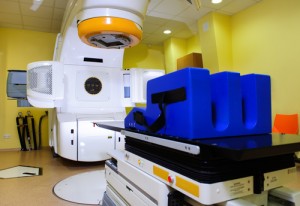 New research presented Sunday, September 14th at the American Society for Radiation Oncology’s (ASTRO’s) 56th Annual Meeting at San Francisco’s Moscone Center, indicates that radiation therapy (RT) does not increase incidence of lymphedema in patients with node-negative breast cancer according to a secondary analysis of the National Surgical Adjuvant Breast and Bowel Project B-32 trial (Krag 2010). The presentation reported outcomes of a randomized trial of sentinel node biopsy (SNB) versus SNB + axillary lymph node dissection (ALND) in 5,611 women with clinically node-negative breast cancer. The study was initiated to determine if SNB was as effective as ALND with fewer side effects.
New research presented Sunday, September 14th at the American Society for Radiation Oncology’s (ASTRO’s) 56th Annual Meeting at San Francisco’s Moscone Center, indicates that radiation therapy (RT) does not increase incidence of lymphedema in patients with node-negative breast cancer according to a secondary analysis of the National Surgical Adjuvant Breast and Bowel Project B-32 trial (Krag 2010). The presentation reported outcomes of a randomized trial of sentinel node biopsy (SNB) versus SNB + axillary lymph node dissection (ALND) in 5,611 women with clinically node-negative breast cancer. The study was initiated to determine if SNB was as effective as ALND with fewer side effects.
The abstract entitled “Impact of Radiation Therapy on Lymphedema Risk and the Agreement Between Subjective and Objective Lymphedema Measures: NSABP B-32 Secondary Data Analysis” is coauthored by S.A. Block, E. McCloskey and P. Ganz of The University of California Los Angeles; H. Bandos, J. Kopec, N. Wolmark, S. Anderson, and D. Krag of the National Surgical Adjuvant Breast and Bowel Project (NSABP), Pittsburgh, PA; T. Julian of NSABP, Pittsburgh, PA; and E. Mamounas of the MD Anderson Cancer Center Orlando, Florida
Although designed to assess the impact of type of axillary surgery specifically on lymphedema risk, the NSABP B-32 trial also provided the opportunity to evaluate the impact of radiation therapy (RT) on lymphedema risk. Lymphedema, a condition of localized fluid retention and tissue swelling, usually in the arm caused by a compromised lymphatic system and/or by removal of or damage to lymph nodes,which normally return interstitial fluid to the thoracic duct and then the bloodstream, is of significant concern for women undergoing breast cancer treatment.
In the study, measures of lymphedema were collected at baseline prior to RT and every 6 months during the 3-year follow-up period. Lymphedema was assessed both by standardized arm measurements by clinicians (objective lymphedema) and via questionnaires completed by patients (subjective lymphedema).
The coauthors note that Lymphedema is a known consequence of locoregional breast cancer therapies; however, it is difficult to separate the independent effects of surgery and radiation therapy (RT). The researchers performed a secondary data analysis of NSABP B-32 clinical trial data to assess the impact of RT on lymphedema risk among women undergoing sentinel node biopsy (SNB) versus axillary lymph node dissection (ALND).
NSABP B-32 was a randomized trial of SNB+ALND versus SNB in women with clinically node negative breast cancer. Measures of lymphedema were collected at baseline and every 6 months over the 3-year follow-up period. We defined objective lymphedema as relative arm volume difference (RAVD) > 10% as determined by a water displacement method, and subjective lymphedema as patient endorsed ipsilateral arm swelling that was “somewhat,” “quite” or “very” bothersome. Repeated measures analyses, chi-square, and Fisher’s exact tests were used to evaluate the association between measures of lymphedema and RT receipt. Kappa coefficient was used to assess agreement between objective and subjective lymphedema measures at individual time points.
[adrotate group=”1″]
According to an ASTRO release, Objective lymphedema (clinician measured) was defined as relative arm volume difference (RAVD) > 10 percent, and was determined by a water displacement method. Subjective lymphedema was defined as patient-reported ipsilateral (occurring in the same arm) swelling that was “somewhat,” “quite” or “very” bothersome. Repeated measures analyses, chi-square and Fisher’s exact tests were used to evaluate the association between measures of lymphedema and RT. Kappa coefficient was used to assess agreement between objective and subjective lymphedema measures at individual time points.
Among 3,916 women in the trial with lymphedema assessments, including 1,936 randomly assigned to SNB+ALND and 1,980 randomly assigned to SNB, 82.2 percent (3,220) received RT and 17.2 percent (674) did not undergo RT. The status was unknown for 0.6 percent (22) of the patients. The original study results showed that SNB+ALND were associated with significantly greater risk of lymphedema vs. SNB alone.
Upon secondary analysis, researchers found no greater risk of lymphedema among women receiving RT vs. among women who did not receive RT. There was no significant difference in standardized arm measurements and no significant difference in patient reports of bothersome arm swelling during three years of follow up, suggesting that radiation does not contribute to lymphedema risk beyond surgery over time. Interestingly, although receipt of radiation did not impact either, there was a lack of agreement between patient reports of bothersome swelling (subjective lymphedema) and clinician measurements of arm swelling (objective lymphedema) throughout the three years of follow-up.
 “These results provide much needed reassurance to breast cancer patients regarding the impact of radiation therapy on lymphedema risk,” comments lead study coauthor Susan McCloskey, MD, MSHS, assistant professor of radiation oncology at The David Geffen School of Medicine at University of California, Los Angeles. “The study findings argue convincingly that radiation therapy to the Level 1 axilla, considered unavoidable “collateral damage” when radiating the whole breast, does not contribute to lymphedema risk beyond surgery. Several recent analyses have suggested that mastectomy rates are on the rise in the United States, and some have suggested that a desire to avoid radiation and its associated toxicities is a contributing factor. This analysis suggests that lymphedema concerns should not be an impediment to women choosing breast conservation and radiation therapy.”
“These results provide much needed reassurance to breast cancer patients regarding the impact of radiation therapy on lymphedema risk,” comments lead study coauthor Susan McCloskey, MD, MSHS, assistant professor of radiation oncology at The David Geffen School of Medicine at University of California, Los Angeles. “The study findings argue convincingly that radiation therapy to the Level 1 axilla, considered unavoidable “collateral damage” when radiating the whole breast, does not contribute to lymphedema risk beyond surgery. Several recent analyses have suggested that mastectomy rates are on the rise in the United States, and some have suggested that a desire to avoid radiation and its associated toxicities is a contributing factor. This analysis suggests that lymphedema concerns should not be an impediment to women choosing breast conservation and radiation therapy.”
The researchers conclude that in this large cohort of patients with prospectively collected data, RAVD > 10 percent was detected in 13 percent of women undergoing ALND and in 7 percent of women undergoing SNB at 36 months. There is no evidence to suggest a detrimental impact of RT on risk of lymphedema beyond surgery. Subjective lymphedema, defined as bothersome to patients, was endorsed less frequently (8% ALND and 3.5% SNB at 36 months) and had a poor agreement with objectively measured RAVD > 10%. Additional analyses of objective data are in progress to evaluate quantification methods that may better correlate with subjective assessments.
ASTRO’s 56th Annual Meeting, held this year at the Moscone Center in San Francisco, September 14-17, 2014, is the nation’s premier scientific meeting in radiation oncology. The 2014 Annual Meeting was projected to attract more than 11,000 attendees including oncologists from all disciplines, medical physicists, dosimetrists, radiation therapists, radiation oncology nurses and nurse practitioners, biologists, physician assistants, practice administrators, industry representatives and other health care professionals from around the world. Led by ASTRO President Bruce G. Haffty, MD, FASTRO, a radiation oncologist specializing in breast cancer, the theme of the 2014 Meeting was “Targeting Cancer: Technology and Biology,” and the Presidential Symposium, “Local-regional Management of Breast Cancer: A Changing Paradigm,” and featured Jay R. Harris, MD, FASTRO, and Thomas A. Buchholz, MD, FASTRO, to highlight recent practice-changing, landmark studies and current developments in the local-regional management of breast cancer.
ASTRO’s four-day scientific meeting included presentation of several plenary papers, 360 oral presentations, 1,862 posters and 144 digital posters in more than 50 educational sessions and scientific panels for 20 disease-site tracks. Three keynote speakers addressed a range of topics including oncologic imaging, biology and targeting in oncology, and human error and safety concerns: Hedvig Hricak, MD, PhD, Chair of the Department of Radiology and the Carroll and Milton Petrie Chair at Memorial Sloan Kettering Cancer Center; Frank McCormick, PhD, FRS, DSc (hon), Professor Emeritus and the David A. Wood Distinguished Professor of Tumor Biology and Cancer Research of the University of California at San Francisco Helen Diller Family Comprehensive Cancer Center; and Sidney Dekker, PhD, MA, MSc, Professor and Director of the Safety Science Innovation Lab at Griffith University, Brisbane, Australia.
ASTRO is the premier radiation oncology society in the world, with more than 10,000 members who are physicians, nurses, biologists, physicists, radiation therapists, dosimetrists and other health care professionals that specialize in treating patients with radiation therapies. As the leading organization in radiation oncology, the Society is dedicated to improving patient care through professional education and training, support for clinical practice and health policy standards, advancement of science and research, and advocacy. ASTRO publishes two medical journals, International Journal of Radiation Oncology Biology Physics (http://www.redjournal.org) and Practical Radiation Oncology (http://www.practicalradonc.org); developed and maintains an extensive patient website, http://www.rtanswers.org; and created the Radiation Oncology Institute (http://www.roinstitute.org), a non-profit foundation to support research and education efforts around the world that enhance and confirm the critical role of radiation therapy in improving cancer treatment.
To learn more about ASTRO, visit http://www.astro.org
Download:
http://mb.cision.com/Main/7260/9643172/286384.pdf
Sources:
American Society for Radiation Oncology
Image Credit:
The David Geffen School of Medicine at University of California, Los Angeles


